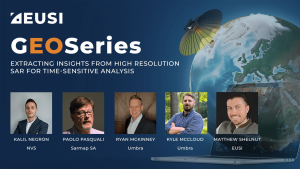Digitising the Third Dimension
- European Space Imaging
Digital Surface Models (DSM) are key components for urban planning, biomass estimation and many more tasks where 3-dimensional data is required. Traditionally, the imagery for those DSMs is collected by two or more shots in sequence within a few seconds. With the current and in particular the future optical systems like WorldView-3 satellite imagery archives which today already have high redundancy will grow even faster. Using this high redundancy and a mixture of imagery for cost effective DSM processing is a logical consequence which offers a huge opportunity for tasks where data actuality is not mandatory.
Using the Third Dimension
In the age of the Global Positioning System (GPS), measuring the height of a single building is a simple task—but measuring the height of every building within hundreds of square kilometers is not feasible. By combining and processing multiple satellite images with photogrammetrical methods, a three dimensional surface model can be reconstructed.
Using state of the art image matching algorithms like Semi-Global Matching (SGM), the resolution of the resulting surface models is equal to the input imagery resolution. For very high-resolution systems like the WorldView satellites, the resulting 0.5m resolution surface models offer the chance for improving classifications, processing true orthophotos, volume calculations, simulations or generating city models. GAF AG is offering such surface models based on multi-stereo satellite images as a standard product.
Processing Surface Models using Archive Imagery
In cooperation with GAF AG and the Remote Sensing Technology Institute (IMF) at DLR Oberpfaffenhofen in his master thesis at Munich University of Applied Sciences, Florian Lang analyzed different scenarios of very high-resolution archive imagery combinations to explore the potential of generating digital surface models.
To analyze a scenario utilizing archived data five WorldView-2 scenes provided by European Space Imaging covering the urban and suburban areas of Madrid were used to create several experimental digital surface models.
Due to the different acquisition angles and dates, the analysis was done on multiple surface models resulting from different combinations of input images (using two, three, four or even five images) to study the effects of image redundancy and temporal difference.
High Success Rates through more Image Redundancy
Especially in urban areas, the archives show high image redundancy, often with a variety of hundreds of images of WorldView-1 and WorldView-2 imagery.
The thesis showed that it is possible to produce digital surface models from multi-temporal archive imagery with a high amount of correct reconstructed pixels.
By choosing only archive data with a well fitting acquisition angle combination and a limited acquisition time difference, the quality of the resulting DSM further improved. Different factors, such as seasonal and locally induced changes, determine the maximum possible time difference between the acquisitions.
Since the archived imagery from the WorldView family of satellites is more economically priced than newly tasked acquisitions it might encourage users with a lower budget to process surface models from archive imagery.
City Models
The 0.5 m spaced surface models created from WorldView very high-resolution satellite imagery support the derivation of highly detailed city models allowing the classification of rooftops. These high resolution surface models build an ideal basis for semi or fully automated derivation of city models.
"Analyzing the huge DigitalGlobe Imagery Archive for suitable imagery with moderate temporal difference and optimal acquisition angles is the key for a successful and complete surface model."
FLORIAN LANG, GAF AG, Munich
Challenge
Analyze the quality and reconstruction percentage of Digital Surface Models from multitemporal high-resolution archive imagery and fi nd a way to handle the data in order to produce the most suitable DSM for the customers needs.
Solution
Using several archived WorldView-2 satellite images provided European Space Imaging to assess different combinations for processing digital surface models.
Results
A cost effective solution for the planning, combining and processing of very high-resolution imagery was developed to generate high-resolutions DSMs.
ABOUT GAF AG
GAF AG, an e-GEOS, Telespazio Company, is globally active and has an international reputation as an experienced provider of project design, management and implementation services in the fields of geo-information, satellite remote sensing, spatial IT-consultancy and capacity building for private and public clients. GAF provides solutions in the sectors of mining and geology, natural resources, water and environment, security, land and renewable resources. Over the past 29 years, GAF has been active in more than 100 countries throughout Europe, Africa, South America and Asia.
Related Stories

GEOSeries: Extracting Insights From High Resolution SAR Imagery for Time-Sensitive Analysis
In this webinar, industry experts and advanced users of Umbra SAR data showcase how they transform SAR imagery into actionable insights in real-world mapping, monitoring and intelligence applications. See how NV5 and Umbra leverage ENVI SAR Essentials for advanced processing with time-efficient results, converting analytics into valuable intelligence.

Using Satellite Imagery to Build Water Resilience Across Europe
Water across Europe is facing severe pressure. Climate change, urbanisation, agricultural demands and other sources of pollution are threatening water security and creating critical challenges that need to be addressed. We have to act quickly, build stronger systems and create sustainable water resilience practices – so that both natural ecosystems and human communities can thrive. Here is how satellite imagery from EUSI can help.

EUSI and Albedo Partner to Deliver 10 cm Resolution Satellite Imagery to Europe
It is our pleasure to announce the partnership with Albedo, a builder of high-performance spacecraft and the first satellite designed to operate commercially in VLEO (Very Low Earth Orbit). This partnership will bring the world’s highest resolution satellite imagery to the European and North African market.

Updating the Land Parcel Identification Systems in 2025: The Benefits of Using Satellite Images
Agricultural paying agencies across Europe face increasing challenges in maintaining accurate and up-to-date Land Parcel Identification Systems (LPIS), ensuring compliance with the Common Agricultural Policy (CAP) and supporting sustainable agricultural practices.





